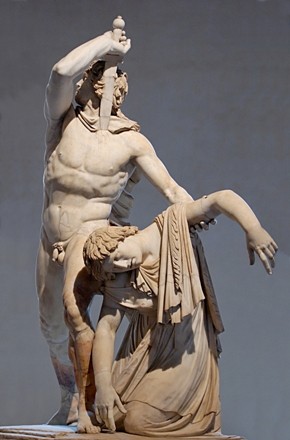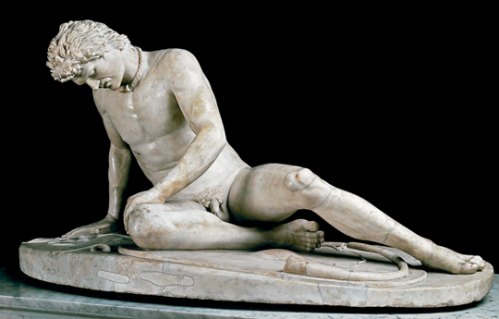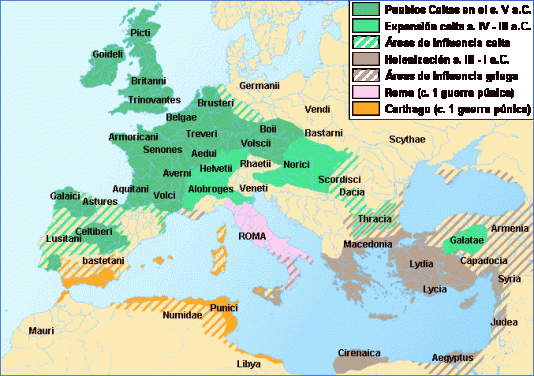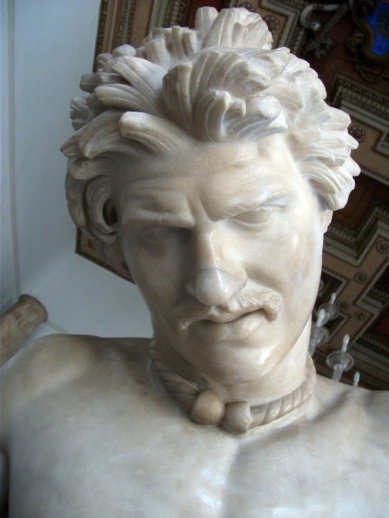 The two more renowned sculptures of the Pergamene School on the Gauls/Galatians: the ‘Dying Gaul’ and the ‘Gaul who commits suicide after having killed his wife’.
The two more renowned sculptures of the Pergamene School on the Gauls/Galatians: the ‘Dying Gaul’ and the ‘Gaul who commits suicide after having killed his wife’.
.
By Periklis Deligiannis
.
This paper is actually a part of my published book The Celts (Γαλάτες), Periscope publ., Athens 2008, unfortunately available only in Greek.
.
I have to refer to an old theory on the Celtic physical anthropology, which even today has a great number of supporters although it is based mainly on a misunderstanding interpretation of the representation – especially of the physical type – of the Galatian warriors by the ‘Pergamene sculpture School’, of the reports of the ancient Greek and Latin authors on the Celts and of other secondary data. This theory is influenced by the ‘Teutonic School’ of physical anthropology in the 19th-early 20th centuries (the archaeologist Gustav von Kossinna and the anthropologist Hans Gunther being its last main representatives), which had a kind of obsession on discovering Nordic warrior nobilities as ruling elites on almost all the ancient European peoples, including the Mediterranean peoples, and also on the Iranians, the Indians, the Egyptians and others. According to the theories of that School, the Nordic noble warriors were the real creators of the Celtic, the Roman, the Greek, the Indian and other ancient civilizations.
The artists of the Hellenized city of Pergamon in Asia Minor, the capital of the Attalid Kingdom, represented in sculptural form some Celts of Anatolian Galatia defeated by king Attalus in a bloody battle around 232 BC. These sculptures are the famous statues known today as the ‘Dying Gaul’, the ‘Gaul who commits suicide after having killed his wife’ and others. Those Gauls, called ‘Galatians’ by the Greeks, came from the valleys of the Danube and the Rhine. The statues of the Pergamene School denote that they physically belonged to the Nordic anthropological type, an element that was considered as a proof that most of the noble Galatian warriors of the ruling class were tall, with mainly blond, fulvous or reddish hair, light eyes, fair skin and other related physical characteristics. According to the aforementioned theory, these were the original Celts while the other physically different compatriots of them were actually Celtisized natives – making up mainly the lower social classes – subjugated by the ‘genuine ones’.
The referred theory has been overthrown long ago by the sciences of genetics, archaeology, physical anthropology and others, but it goes on influencing the general reader on whom the Celts are often represented almost in their entirety as typical Nordics. The Nordic physical type actually characterized only a part of them who clearly were not their ruling class. Human remains found in burials of Celtic nobles across the Celtic/Gallic World from Ireland and Portugal to Southern Poland and Central Asia Minor, usually accompanied by heavy weaponry, denote that they equally belonged to other physical anthropological types beyond the Nordic. It is almost impossible to deduce the racial type of the original Celts and most likely there was never such a type, although the first Proto-Celts of the Urnfield Culture were possibly physically identified with the earlier Βell Beaker Folk, a folk physically neither Nordic nor Alpine.
The Celtic World
.
The Celtic populations in their long history always consisted of a fusion of several different morphological/physical types. It is worth presenting a quick summary of their morphological/physical status in Antiquity: Following mainly the terminology of Carleton Coon which remains the most scientific though generally considered obsolete, the inhabitants of Greater Gaul (that is approximately modern France, Belgium, Luxemburg and the Rhineland) belonged usually to the Alpine anthropological type, and also to the Mediterranean, the Nordic proper, the Borreby-Nordic, the Atlantic variety of Dinaric (represented today mostly by the Pre-Indoeuropean Basques), the Noric (Northern Dinaric, with light colours of hair and eyes), and to other types. The Celtic Celtiberians, Cantabri, Astures, Vaccaei, Gallaeci and the probably Proto-Celtic Lusitani of Spain and Portugal were morphologically mainly Western Mediterranean, Atlanto-Dinaric (especially the Gallaeci, Cantabri and Astures) and other, and some of them physically consisted individual pockets of survivors of the ancient manufacturers of the Megalithic monuments in Western Europe (the oddly-called ‘Megalithic physical type’). The Celts of the British Isles were physically Atlanto-Mediterranean (Briton-Mediterranean or Celto-Med), Alpine, Nordic proper, Brünn-Nordic, “Megalithic” and some of them were clearly dolichocephal survivors of the Upper Paleolithic Age.
The Celts of Central and Eastern Europe were mixed Alpine, Nordic, Dinaric proper, Noric (Northern Dinaric), Mediterranean (in the Balkan Peninsula), Borreby-Nordic and other. The Celts who settled in Asia Minor (Galatians) came from the valleys of the Danube and the Rhine. The Nordic Celts were very few in the Danube area, were found to some proportion in the banks of the Rhine and formed the majority of the population only at the mouth of the Rhine, on the North Sea coast. In overall on the mentioned areas, the Alpine type seems to have been the most common, coexisting with several others (the aforementioned basic types and much more intermediate types that I cannot mention in this limited paper) while the Nordics (proper, Borreby, Brünn, Falo-Dalisch and other) consisted a rather limited portion of the total Celtic-speaking population (being more than 10,000,000 around 200 BC). The only Celtic areas where the Alpine type was not the most common, were the lands of the Celtiberians and the Lusitani, the Gallic Thrace (Kingdom of Tylis) and the British Islands, where the Meds and the Atlanto-Meds had been the commonest types.
I have to explain why the Pergamene Greek sculptors had chosen the representation specifically of the Nordic Galatians in the aformentioned statues. The answer lies in the exotic look of those warriors in the Greek eyes. The Mediterranean peoples were accustomed to see all the European anthropological morphological types except the Nordic, the East Baltic and a few more. Especially the big stature of the Nordic Gauls, their physique, the colours of their hair, eyes and skin, and generally their entire display would surely had impressed the Pergamenes. As the British historian W.W. Tarn mentions in his work on Antigonos Gonatas: “.. the wild Gauls from the North Sea, full-bodied and redhead, looked so strange in Greek eyes …”.
Exactly for the same reasons, the Latin authors focused on the description of Celtic warriors specifically of the Nordic type, when the Romans confronted them on the battlefield. The Nordic Celts were a rather limited portion of the Gallic warriors who invaded Italy, Greece and Asia Minor in the 4th-3rd cent. BC, but they constituted an elite force because of their physique. On the other hand, their impressive physique does not denote that they were better warriors than the other Gauls. Their shorter and more slender compatriots who consisted the majority of the Gallic/Celtic armies, had a low center of gravity, a characteristic that was giving them greater flexibility and possibly greater endurance during the conflict, while we may assume that they did not lack in bravery and impetuosity. In addition there is no sufficient evidence that they were lighter armed or ‘auxiliaries’ comparatively to their Nordic compatriots, as they are considered to have been by the supporters of the “Nordic-Celtic theory”.
The predominance of the Nordic Gauls in combat and consequently in the sculptures, depictions and writings of the Greeks and Romans was due especially to the Celtic warfare and tactics which were largely based on the demonstration of the warrior’s physique in order to intimidate the enemy and on the use of the advantages of that strong physique on a Mêlée conflict which was usually a series of duels. The tall and full-bodied warriors would obviously have an important advantage. In contrast, the Mediterranean peoples’ tactics (Greek and Roman) did not dependent on this ‘inane sensationalism’ and on the outdated heroic duels, but on the essential mass conflict, the real combat of phalanx-type warfare.
For these reasons, when the Nordic Gauls confronted the Mediterranean peoples, despite their initial victories and the terror and panic that they caused to them, they had soon been repeatedly defeated by the Hellenic hoplites and sarissophoroi and the Roman legionaries; for example in the battles of Dolopia, Parnassus, Lysimacheia, the Caicus River, Pergamon, Sentinum, Lake Vadimon, Sena Gallica, Telamon and other conflicts of the 3rd century BC. On the other hand, the claim of the Greek writers that their compatriots managed to repel the Gauls at Delphi (279 BC), is not true. The Gauls rather managed to plunder the sanctuary or a part of it, before they were defeated at the slopes of Parnassus. Αnd of course, they sacked intensively Rome in 387 BC, destroying a part of the city despite Livius’ claims.
The face of the ‘Dying Gaul’; a figure usually classified as Nordic.
.
However, the Celts of the Nordic type were undoubtedly an elite force of the Gallic armies. The renowned large Celtic mercenary fraternities of the Gaesatae or Gaisati would have been composed mostly of them, a situation indicated by the Latin sources (for example in the Battle of Telamon 225 BC). Due to the Celtic organization in military groups which corresponded to tribes or sub-tribes, the Nordic Galatians involved in the invasion of Asia Minor (276 BC) would correspond to one or more tribes or sub-tribes which started migrating from the mouth of the Rhine. Most of them were probably organized into an independent military elite of the Celtic horde in Asia Minor and because of their distinguished character and appearance, they were the ones who were immortalized in the Pergamene statues. But by inference, the Nordic Celts generally – including the Anatolian Galatians – were not the ruling class of their people, nor did they account in appearance the average Celt warrior.
.
.
ANCIENT SOURCES
Polybius: Histories, Loeb Classical Library.
Diodorus Siculus: Historical Library, Loeb Classical Library.
Livy: Roman History (Ab Urbe Condita) Loeb Classical Library.
Julius Caesar: De Bello Gallico, Loeb Classical Library.
.
MODERN BIBLIOGRAPHY
Baker John: Race, 1974.
Powell, T.G.E.: The Celts, New Edition 1980.
Rankin H.D.: The Celts and the Classical World, 1987.
Coon C.S.: The Races of Europe, 1939.
Hubert Henry: The Rise of the Celts, Constable, 1987
Laing, L.: Celtic Britain, 1979.










Anthropology - Evolutionary Ego « Unseen World
Jan 31, 2014 @ 19:47:53
Nov 07, 2016 @ 23:54:44
You seem so sure of yourself friend. Maybe you forgot the whole hero worship aspect to Greek religion, which perhaps indicates why these statues where made in this type and placed near the altar to Zeus on the Pergamene Acropolis. I’m sure you understand the main physical descriptions of ancient Greek Gods and Heros, don’t you?
Dec 01, 2016 @ 11:01:55
Frankly, I am not so sure for myself. As for the main physical descriptions of ancient Greek Gods and Heros, and the whole hero worship aspect to Greek religion, these Gods and Heros are mainly of the Eastern Med morphological type (not my conclusion: see Angel, Lundman and others) that is the most usual physical type among the ancient Greeks